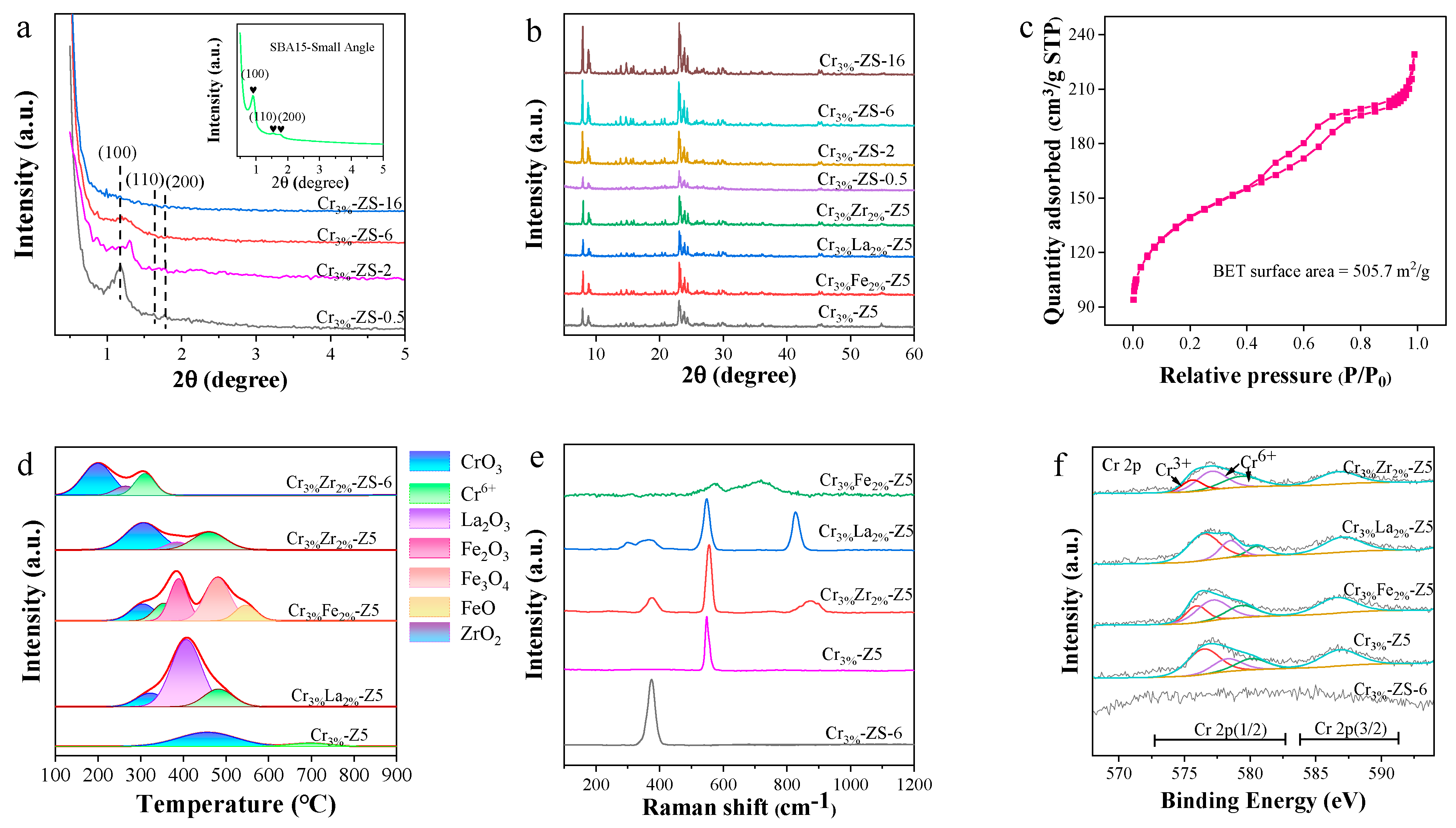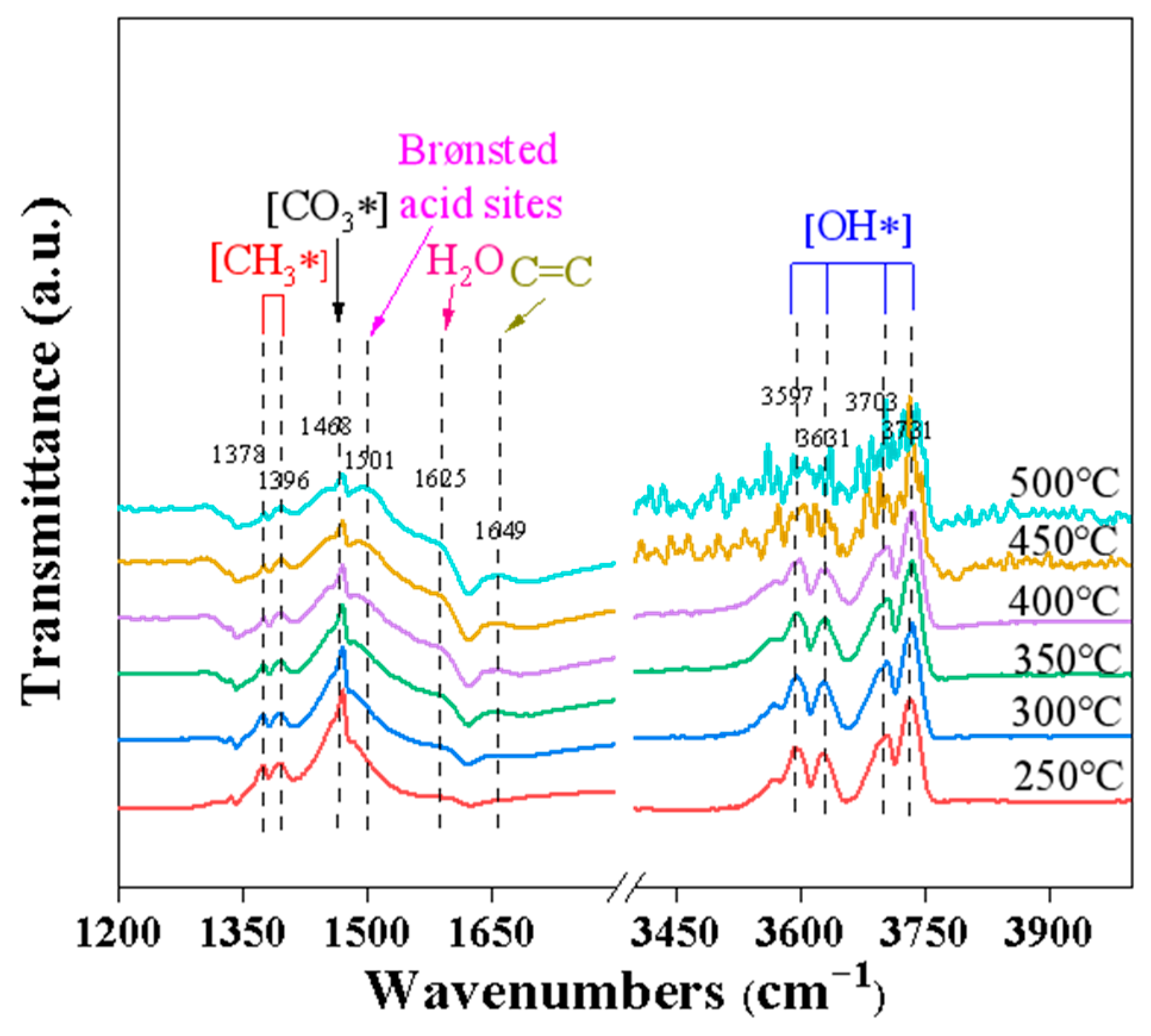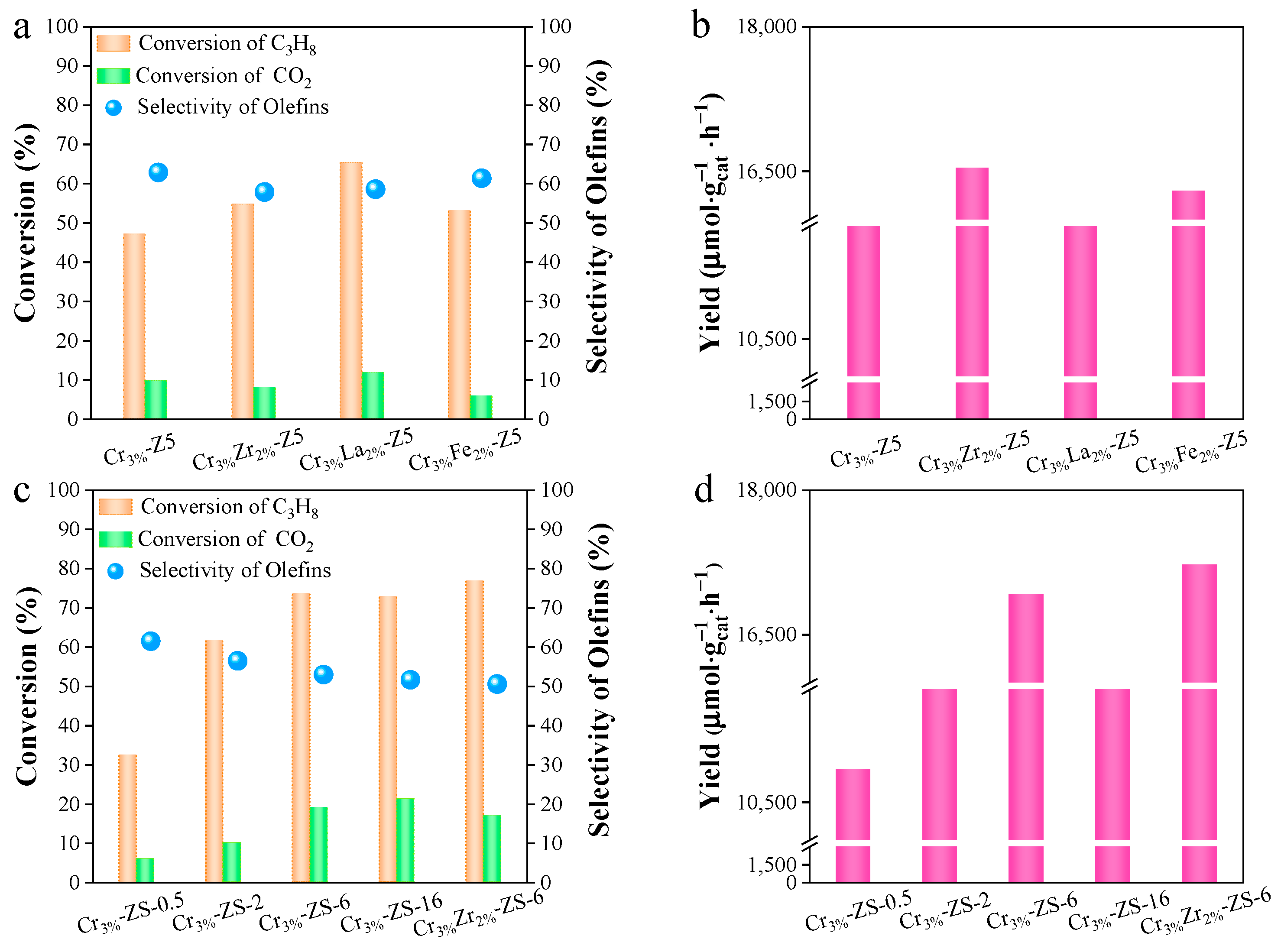CO2 Oxidative Dehydrogenation of Propane to Olefin over Cr-M (M = Zr, La, Fe) Based Zeolite Catalyst
Abstract
1. Introduction
2. Results and Discussion
2.1. Characterization of Catalysts
2.2. Reaction Mechanism Investigation
2.3. Catalytic Activity of Cr-Based Catalysts
3. Material and Methods
3.1. Preparation of Cr-Based ZSM-5 Zeolite Catalyst
3.2. Preparation of Cr-Based ZSM-5@SBA-15 Composite Zeolite Catalyst
3.3. Characterizations
3.4. Catalytic Test
4. Conclusions
Supplementary Materials
Author Contributions
Funding
Data Availability Statement
Conflicts of Interest
References
- Atanga, M.A.; Rezaei, F.; Jawad, A.; Fitch, M.; Rownaghi, A.A. Oxidative dehydrogenation of propane to propylene with carbon dioxide. Appl. Catal. B Environ. 2018, 220, 429–445. [Google Scholar] [CrossRef]
- Bagheri, S.; Julkapli, N.M. Mo3VOx catalyst in biomass conversion: A review in structural evolution and reaction pathways. Int. J. Hydrogen Energy. 2017, 42, 2116–2126. [Google Scholar] [CrossRef]
- Li, C.; Wang, G. Dehydrogenation of light alkanes to mono-olefins. Chem. Soc. Rev. 2021, 50, 4359–4381. [Google Scholar] [CrossRef]
- Yuan, Y.; Porter, W.N.; Chen, J.G. Comparison of direct and CO2-oxidative dehydrogenation of propane. Trends. Chem. 2023, 5, 840–852. [Google Scholar] [CrossRef]
- Shou, H.; Dasari, P.R.; Broekhuis, R.R.; Mondal, A.; Patel, A.; Nguyen, C.; Fickel, D.W. Cracking of Butane on a Pt/H-ZSM-5 Catalyst in the Presence of Hydrogen. Ind. Eng. Chem. Res. 2022, 61, 4763–4773. [Google Scholar] [CrossRef]
- Hu, Z.-P.; Yang, D.; Wang, Z.; Yuan, Z.-Y. State-of-the-art catalysts for direct dehydrogenation of propane to propylene. Chin. J. Catal. 2019, 40, 1233–1254. [Google Scholar] [CrossRef]
- Qu, Y.; Li, G.; Zhao, T.; Zhang, Z.; Douthwaite, M.; Zhang, J.; Hao, Z. Low-temperature direct dehydrogenation of propane over binary oxide catalysts: Insights into geometric effects and active sites. ACS Sustain. Chem. Eng. 2021, 9, 12755–12765. [Google Scholar] [CrossRef]
- Mukherjee, D.; Park, S.-E.; Reddy, B.M. CO2 as a soft oxidant for oxidative dehydrogenation reaction: An eco benign process for industry. J. CO2 Util. 2016, 16, 301–312. [Google Scholar] [CrossRef]
- Otroshchenko, T.; Jiang, G.; Kondratenko, V.A.; Rodemerck, U.; Kondratenko, E.V. Current status and perspectives in oxidative, non-oxidative and CO2-mediated dehydrogenation of propane and isobutane over metal oxide catalysts. Chem. Soc. Rev. 2021, 50, 473–527. [Google Scholar] [CrossRef]
- Lian, Z.; Si, C.; Jan, F.; Zhi, S.; Li, B. Coke deposition on Pt-based catalysts in propane direct dehydrogenation: Kinetics, suppression, andl eimination. ACS Catal. 2021, 11, 9279–9292. [Google Scholar] [CrossRef]
- Zhu, J.; Wang, T.; Xu, X.; Xiao, P.; Li, J. Pt nanoparticles supported on SBA-15: Synthesis, characterization and applications in heterogeneous catalysis. Appl. Catal. B Environ. 2013, 130, 197–217. [Google Scholar] [CrossRef]
- Dai, Y.; Gao, X.; Wang, Q.; Wan, X.; Zhou, C.; Yang, Y. Recent progress in heterogeneous metal and metal oxide catalysts for direct dehydrogenation of ethane and propane. Chem. Soc. Rev. 2021, 50, 5590–5630. [Google Scholar] [CrossRef] [PubMed]
- Barsan, M.M.; Thyrion, F.C. Kinetic study of oxidative dehydrogenation of propane over Ni-Co molybdate catalyst. Catal. Today 2003, 81, 159–170. [Google Scholar] [CrossRef]
- Liu, D.; Cao, L.; Zhang, G.; Zhao, L.; Gao, J.; Xu, C. Catalytic conversion of light alkanes to aromatics by metal-containing HZSM-5 zeolite catalysts-A review. Fuel Process. Technol. 2021, 216, 106770. [Google Scholar] [CrossRef]
- Yuan, Y.; Zhao, Z.; Lobo, R.F.; Xu, B. Site diversity and mechanism of metal-exchanged zeolite catalyzed non-oxidative propane dehydrogenation. Adv. Sci. 2023, 10, 2207756. [Google Scholar] [CrossRef] [PubMed]
- Madeira, L.M.; Portela, M.F.; Mazzocchia, C. Nickel molybdate catalysts and their use in the selective oxidation of hydrocarbons. Catal. Rev. Sci. Eng. 2004, 46, 53–110. [Google Scholar] [CrossRef]
- Love, A.M.; Cendejas, M.C.; Thomas, B.; McDermott, W.P.; Uchupalanun, P.; Kruszynski, C.; Burt, S.P.; Agbi, T.; Rossini, A.J.; Hermans, I. Synthesis and characterization of silica-supported boron oxide catalysts for the oxidative dehydrogenation of propane. J. Phys. Chem. C 2019, 123, 27000–27011. [Google Scholar] [CrossRef]
- Silva, B.; Figueiredo, H.; Soares, O.S.G.P.; Pereira, M.F.R.; Figueiredo, J.L.; Lewandowska, A.E.; Banares, M.A.; Neves, I.C.; Tavares, T. Evaluation of ion exchange-modified Y and ZSM5 zeolites in Cr(VI) biosorption and catalytic oxidation of ethyl acetate. Appl. Catal. B Environ. 2012, 117, 406–413. [Google Scholar] [CrossRef]
- Igonina, M.; Tedeeva, M.; Kalmykov, K.; Kapustin, G.; Nissenbaum, V.; Mishin, I.; Pribytkov, P.; Dunaev, S.; Kustov, L.; Kustov, A. Properties of CrOx/MCM-41 and its catalytic activity in the reaction of propane dehydrogenation in the presence of CO2. Catalysts 2023, 13, 906. [Google Scholar] [CrossRef]
- Singh, R.; Nayak, S.C.; Singh, R.; Deo, G. O2 and CO2 assisted oxidative dehydrogenation of propane using ZrO2 supported vanadium and chromium oxide catalysts. Catal. Today 2024, 432, 114617. [Google Scholar] [CrossRef]
- Zhang, L.; Chen, K.; Chen, H.; Han, X.; Liu, C.; Qiao, L.; Wu, W.; Yang, B. Elucidating the promoting advantages and fundamentals for their creation in Sn-modified commercial CrOx/Al2O3 catalyst for propane dehydrogenation. Chem. Eng. J. 2024, 483, 149366. [Google Scholar] [CrossRef]
- Razavian, M.; Fatemi, S. Synthesis and application of ZSM-5/SAPO-34 and SAPO-34/ZSM-5 composite systems for propylene yield enhancement in propane dehydrogenation process. Micropor. Mesopor. Mat. 2015, 201, 176–189. [Google Scholar] [CrossRef]
- Zhang, L.; Zhao, Y.; Dai, H.; He, H.; Au, C.T. A comparative investigation on the properties of Cr-SBA-15 and CrOx/SBA-15. Catal. Today 2008, 131, 42–54. [Google Scholar] [CrossRef]
- Ji, F.; Li, C.; Liu, Y.; Liu, P. Heterogeneous activation of peroxymonosulfate by Cu/ZSM5 for decolorization of Rhodamine B. Sep. Purif. Technol. 2014, 135, 1–6. [Google Scholar] [CrossRef]
- Kim, M.-S.; Lee, D.-W.; Chung, S.-H.; Hong, Y.-K.; Lee, S.H.; Oh, S.-H.; Cho, I.-H.; Lee, K.-Y. Oxidation of ammonia to nitrogen over Pt/Fe/ZSM5 catalyst: Influence of catalyst support on the low temperature activity. J. Hazard. Mater. 2012, 237, 153–160. [Google Scholar] [CrossRef] [PubMed]
- Saba, T.; Estephane, J.; El Khoury, B.; El Khoury, M.; Khazma, M.; El Zakhem, H.; Aouad, S. Biodiesel production from refined sunflower vegetable oil over KOH/ZSM5 catalysts. Renew. Energy 2016, 90, 301–306. [Google Scholar] [CrossRef]
- Tian, J.; Guan, J.; Xu, M.; Qian, S.; Ma, K.; Wan, S.; Zhang, Z.; Xiong, H.; Wang, S.; Wang, Y.; et al. Repairing vacancy defects for stabilization of high surface area hexagonal boron nitride under harsh conditions. Chem. Eng. J. 2023, 475, 146015. [Google Scholar] [CrossRef]
- Aboul-Enein, A.A.; Soliman, F.S.; Betiha, M.A. Co-production of hydrogen and carbon nanomaterials using NiCu/SBA15 catalysts by pyrolysis of a wax by-product: Effect of Ni-Cu loading on the catalytic activity. Int. J. Hydrogen Energy 2019, 44, 31104–31120. [Google Scholar] [CrossRef]
- Yang, W.; Liu, H.; Li, Y.; Wu, H.; He, D. CO2 reforming of methane to syngas over highly-stable Ni/SBA-15 catalysts prepared by P123-assisted method. Int. J. Hydrogen Energy 2016, 41, 1513–1523. [Google Scholar] [CrossRef]
- Al-Awadi, A.S.; El-Toni, A.M.; Al-Zahrani, S.M.; Abasaeed, A.E.; Alhoshan, M.; Khan, A.; Labis, J.P.; Al-Fatesh, A. Role of TiO2 nanoparticle modification of Cr/MCM41 catalyst to enhance Cr-support interaction for oxidative dehydrogenation of ethane with carbon dioxide. Appl. Catal. A Gen. 2019, 584, 117114. [Google Scholar]
- Zhang, Q.-H.; Yan, F.; Xia, W.; Liu, C. Study of the coordinative nature of alkylaluminum modified Phillips CrOx/SiO2 catalyst by multinucleai solid-state NMR. Pet. Sci. 2013, 10, 577–583. [Google Scholar] [CrossRef]
- Zhang, S.; Zhou, C.-A.; Wang, S.; Qin, Z.; Shu, G.; Wang, C.; Song, L.; Zheng, L.; Wei, X.; Ma, K.; et al. Facilitating CO2 dissociation via Fe doping on supported vanadium oxides for intensified oxidative dehydrogenation of propane. Chem. Eng. J. 2024, 481, 148231. [Google Scholar] [CrossRef]
- Ma, Z.; Xu, W.; Wang, Q.; Zhou, Q.; Zhou, J. Highly effective microwave catalytic oxidative dehydrogenation of propane by CO2 over V-La-doped dendritic mesoporous silica-based microwave catalysts. Chem. Eng. J. 2022, 435, 135081. [Google Scholar] [CrossRef]
- Zhang, Y.; Yu, Y.; Wang, R.; Dai, Y.; Bao, L.; Li, M.; Zhang, Y.; Liu, Q.; Xiong, D.; Wu, Q.; et al. Identifying the active site and structure-activity relationship in propane dehydrogenation over Ga2O3/ZrO2 catalysts. J. Catal. 2023, 428, 115208. [Google Scholar] [CrossRef]
- Shao, H.; Wang, X.; Gu, X.; Wang, D.; Jiang, T.; Guo, X. Improved catalytic performance of CrOx catalysts supported on foamed Sn-modified alumina for propane dehydrogenation. Micropor. Mesopor. Mater. 2021, 311, 110684. [Google Scholar] [CrossRef]
- Wang, J.; Song, Y.-H.; Liu, Z.-T.; Liu, Z.-W. Active and selective nature of supported CrOx for the oxidative dehydrogenation of propane with carbon dioxide. Appl. Catal. B Environ. 2021, 297, 120400. [Google Scholar] [CrossRef]
- Sun, G.; Huang, Q.; Li, H.; Liu, H.; Zhang, Z.; Wang, X.; Wang, Q.; Wang, J. Different supports-supported Cr-based catalysts for oxidative dehydrogenation of isobutane with CO2. Chin. J. Catal. 2011, 32, 1424–1429. [Google Scholar] [CrossRef]
- Scire, S.; Fiorenza, R.; Gulino, A.; Cristaldi, A.; Riccobene, P.M. Selective oxidation of CO in H2-rich stream over ZSM5 zeolites supported Ru catalysts: An investigation on the role of the support and the Ru particle size. Appl. Catal. A Gen. 2016, 520, 82–91. [Google Scholar]
- Zhang, S.; Ying, M.; Yu, J.; Zhan, W.; Wang, L.; Guo, Y.; Guo, Y. NixAl1O2-δ mesoporous catalysts for dry reforming of methane: The special role of NiAl2O4 spinel phase and its reaction mechanism. Appl. Catal. B Environ. 2021, 291, 120074. [Google Scholar] [CrossRef]
- Karina Mathisen, D.G.N.; Andrew, M. Beale, Manuel Sanchez-Sanchez, Gopinathan Sankar, Wim Bras, and Serge Nikitenko. The selective catalytic reduction of NOx with CH4 on Mn-ZSM5: A comparison with Co-ZSM5 and Cu-ZSM5. Appl. Catal. B Environ. 2007, 111, 3130–3138. [Google Scholar]
- Liu, Z.; Zhang, F.; Rui, N.; Li, X.; Lin, L.; Betancourt, L.E.; Su, D.; Xu, W.; Cen, J.; Attenkofer, K.; et al. Highly active ceria-supported Ru catalyst for the dry reforming of methane: In situ identification of Ruδ+–Ce3+ interactions for enhanced conversion. ACS Catal. 2019, 9, 3349–3359. [Google Scholar] [CrossRef]
- Shishido, T.; Shimamura, K.; Teramura, K.; Tanaka, T. Role of CO2 in dehydrogenation of propane over Cr-based catalysts. Catal. Today 2012, 185, 151–156. [Google Scholar] [CrossRef]
- Sokolov, S.; Stoyanova, M.; Rodemerck, U.; Linke, D.; Kondratenko, E.V. Comparative study of propane dehydrogenation over V-, Cr-, and Pt-based catalysts: Time on-stream behavior and origins of deactivation. J. Catal. 2012, 293, 67–75. [Google Scholar] [CrossRef]
- Kresse, G.; Furthmuller, J. Efficient iterative schemes for ab initio total-energy calculations using a plane-wave basis set. Phys. Rev. B 1996, 54, 11169–11186. [Google Scholar] [CrossRef]




| Sample | SBET a, m2/g | Cr6+/(Cr6+ + Cr3+) |
|---|---|---|
| Cr3%-Z5 | 367.7 | 46.9% |
| Cr3%Zr2%-Z5 | 324.2 | 71.1% |
| Cr3%La2%-Z5 | 363.2 | 68.2% |
| Cr3%Fe2%-Z5 | 376.2 | 73.9% |
| Cr3%-ZS-0.5 | 456.2 | — |
| Cr3%-ZS-2 | 469.8 | — |
| Cr3%-ZS-6 | 505.7 | — |
| Cr3%-ZS-16 | 403.0 | — |
Disclaimer/Publisher’s Note: The statements, opinions and data contained in all publications are solely those of the individual author(s) and contributor(s) and not of MDPI and/or the editor(s). MDPI and/or the editor(s) disclaim responsibility for any injury to people or property resulting from any ideas, methods, instructions or products referred to in the content. |
© 2024 by the authors. Licensee MDPI, Basel, Switzerland. This article is an open access article distributed under the terms and conditions of the Creative Commons Attribution (CC BY) license (https://creativecommons.org/licenses/by/4.0/).
Share and Cite
Xing, M.; Liu, N.; Dai, C.; Chen, B. CO2 Oxidative Dehydrogenation of Propane to Olefin over Cr-M (M = Zr, La, Fe) Based Zeolite Catalyst. Catalysts 2024, 14, 370. https://doi.org/10.3390/catal14060370
Xing M, Liu N, Dai C, Chen B. CO2 Oxidative Dehydrogenation of Propane to Olefin over Cr-M (M = Zr, La, Fe) Based Zeolite Catalyst. Catalysts. 2024; 14(6):370. https://doi.org/10.3390/catal14060370
Chicago/Turabian StyleXing, Mingqiao, Ning Liu, Chengna Dai, and Biaohua Chen. 2024. "CO2 Oxidative Dehydrogenation of Propane to Olefin over Cr-M (M = Zr, La, Fe) Based Zeolite Catalyst" Catalysts 14, no. 6: 370. https://doi.org/10.3390/catal14060370
APA StyleXing, M., Liu, N., Dai, C., & Chen, B. (2024). CO2 Oxidative Dehydrogenation of Propane to Olefin over Cr-M (M = Zr, La, Fe) Based Zeolite Catalyst. Catalysts, 14(6), 370. https://doi.org/10.3390/catal14060370








